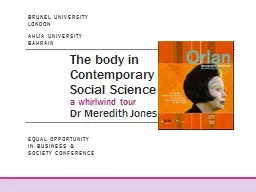

a whirlwind tour Dr Meredith Jones BRUNEL UNIVERSITY LONDON AHLIA UNIVERSITY BAHRAIN EQUAL OPPORTUNITY IN BUSINESS amp SOCIETY CONFERENCE The Body Or Many Bodies The Absent Body ID: 751537
Download Presentation The PPT/PDF document "The body in Contemporary Social Science" is the property of its rightful owner. Permission is granted to download and print the materials on this web site for personal, non-commercial use only, and to display it on your personal computer provided you do not modify the materials and that you retain all copyright notices contained in the materials. By downloading content from our website, you accept the terms of this agreement.
Slide1
The body in Contemporary Social Sciencea whirlwind tourDr Meredith Jones
BRUNEL UNIVERSITY LONDON AHLIA UNIVERSITY BAHRAINEQUAL OPPORTUNITY IN BUSINESS & SOCIETY CONFERENCESlide2Slide3
The Body? Or Many Bodies?The Absent BodyThe Social BodyThe Sensing BodyThe Docile Body
The Gendered BodyThe Modified BodyThe Cyborg BodySlide4
The Absent BodyCogito ergo sum (I think, therefore I am)Mind/body dualism
Mind and matter (body) are two ontologically separate categoriesThe body is a machineMind = conscious selfCartesianism (via Descartes)Truths can only be found through thinking, not through sensation or physical experience
The mind is superior to the body
Mind
=
human/culture/male/rational
Body
= animal/nature/female/irrational
Rene Descartes (
1596-1650)
I
know now that even bodies are not perceived by the senses or the faculty of imagining, but are perceived only by the mind, and that they are not perceived by being touched or seen but only by being understood, and therefore I know clearly that there is nothing that can be perceived by me more easily or more clearly than my own mind
.Slide5
The Social BodyMind and body are
inextricably linked.How we understand our bodies depends on our society and culture.
Bodies
are
biological
but are also
social
and cultural.
We learn through our bodiesThe body is shaped by Institutions,
Consumption; Beliefs; Values; Politics; Media; Space; Time… etcThe body is the social world but the social world is the body. Pierre Bourdieu, 1990The very possibility of the social world, rooted as it is in interaction, rests upon our embodiment… our bodies are … our very means of experiencing
.
Nick
Crossley, 2001Slide6
The sensing body(phenomenology)Inside and outside are inseparable. The world is wholly inside and I am wholly outside myself.
Maurice Merleau-Ponty, The Phenomonolgy of Perception, 1945
Bodies are our primary sites of
knowing, discovering, understanding
the
world.
Bodies
are
intelligent and sense-making.
Bodies are responsive, active, in dialogue with the social and cultural world.They are always both touching and touched, seeing and seen, sensing and being sensed.Slide7
He who is subjected to a field of visibility, and who knows it, assumes responsibility for the constraints of power; he makes them play spontaneously upon himself; he inscribes in himself the power relation in which he simultaneously plays both roles; he becomes the principle of his own
subjection. Michel Foucault, Discipline and Punish: The Birth of the Prison, 1977The Docile
Body
Discipline is achieved through surveillance of bodies rather than physical force
Enacted via various
institutions and their discourses:
schools, prisons, governments, factories
Self-monitoring of bodies,
self-surveillance, is a ‘productive
form’ of powerSlide8
The Gendered BodyWe are always under duress to give the gendered performance expected from us. Performative acts which construct gender may appear ostensibly as a personal choice, but always work within the existing framework of cultural sanctions and proscriptions, of a “shared social
structure.Judith Butler, Gender Trouble: Feminism and the Subversion of Identity, 1990
Society teaches us how to ‘do’ gender.
It is ‘performed’ but still always
‘
constrained
by available historical
conventions.’
We are usually unconscious of performing our gender.
Many body modifications are connected to gender performativity.
There can be severe ramifications for not performing gender ‘correctly’.Slide9
The modified or marked bodyB
odies as expressive; bodies as cultural signsClothing, Tattooing, Makeup, Piercing,
Hairdressing, hair removal, Cosmetic
surgery, Dental work, Dieting, Obesity,
Gymwork
,
Bodybuilding
Why
are some body modifications acceptable (even mandatory) while others are considered ugly or unnatural?
What are the cultural/historical/social significances of various body modifications?What can body modifications tell us about the values, morals & beliefs of the cultures we inhabit & create?The marked body signals the fact that bodies are eminently cultural signs…The cultural ideals of Western beauty are symbolized by the technological manipulation of the human body.Anne Balsamo, Forms of Technological Embodiment: Reading the Body in Contemporary Culture
1995Slide10
The cyborg body
CYBORGS mix organic and non organic
elements
. They can be used
to think
about:
Nature/culture
relations
Human/technology relations
Human/animal relationsBy the late twentieth century, our time, a mythic time, we are all chimeras, theorized and fabricated hybrids of machine and organism; in short, we are cyborgs. Donna Haraway,
A
Cyborg Manifesto: Science, Technology, and Socialist-Feminism in the Late Twentieth
Century,
1984Slide11
Patricia Piccinini, The Young Family, 2002, silicone, acrylic, human hair, leather, timber, 80.0 x 150.0 x 110.0 cm, Photograph by Graham BaringSlide12
TOMORROW:The mediated body (media-bodies)WE CREATE MEDIA BUT THEY ALSO CREATE USWe will explore how bodies are mediated via:Visual Cultures
Cosmetic Surgery